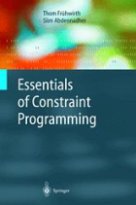From the reviews:
"The book distinguishes itself as a concise, formal introduction to the field of constraint programming. In general, concision and precision come in pairs in this book, and the authors should be congratulated for this. … the uniform style of this book makes it easier and easier to be read. Its structure is also well designed and concocts to create a fluid presentation … . Anybody looking for a formal, essential but never shallow introduction to the field should definitely consider this book." (Rosella Gennari, Journal of Logic, Language and Information, Vol. 14, 2005)
Product Description
The book is a short, concise and complete presentation of constraint programming and reasoning. The use of constraints had its scientific and commercial breakthrough in the 1990s. Programming with constraints makes it possible to model and solve problems with uncertain, incomplete information and combinatorial problems, as they are abundant in industry and commerce, such as scheduling, planning, transportation, resource allocation, layout, design and analysis. The theoretically well-founded presentation includes application examples from real life. It introduces the common classes of constraint programming languages and constraint systems in a uniform way. Constraint solving algorithms are specified and implemented in the constraint handling rules language (CHR).
This book is ideally suited as a textbook for graduate students and as a resource for researchers and practitioners. The Internet support includes teaching material, software, latest news and online use and examples of the CHR language.

